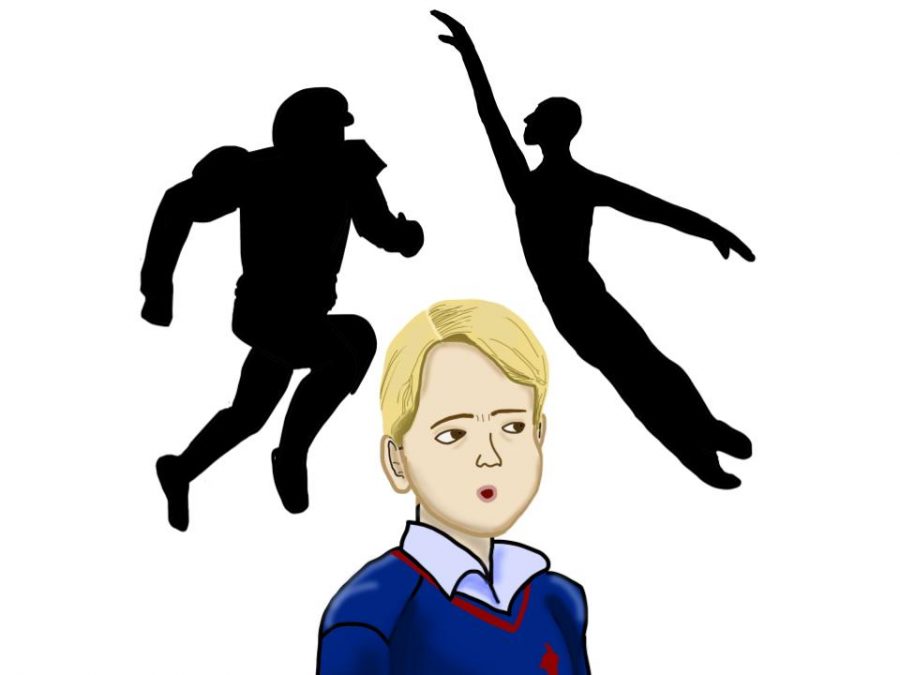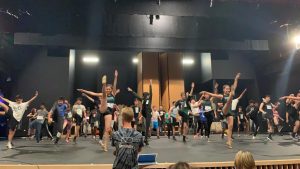Boys can dance: Insensitive comments show that toxic stereotypes live on — but shouldn’t
September 17, 2019
Imagine a ballet dancer. Did you summon an image of a lithe woman with a bun, clad in a tutu and pointe shoes? Or did you instead conjure a sinewed, muscular man elegantly leaping several feet in the air?
Now consider these iconic men from professional sports and Hollywood: Rob Gronkowski, Herschel Walker, Lynn Swann, Mikhail Baryshnikov, Rudolph Nureyev, Gene Kelly, Patrick Swayze, Channing Tatum.
What do all these famous iconic male figures have in common?
They all studied ballet.
Although the ongoing movement against toxic masculinity has liberated men from restraints of long-standing gender-based roles and expectations, these pejorative tropes still live on in the world of dance.
When Good Morning America anchor Lara Spencer joked about 6-year-old Prince George’s dance curriculum on Aug. 23, her comment first spread throughout the dance community, then went viral in pop culture. What was originally meant to lightly mock the tiny royal male’s choice instead reinforced a wrong-headed cultural bias about men and ballet.
“Oh, he looks so happy about the ballet class,” she said. “Prince William said Prince George absolutely loves ballet … I have news for you, Prince William: we’ll see how long that lasts.”
After receiving attacks on her offensive statement online, Spencer publicly apologized on GMA soon after, explaining that she had no idea that her “joke” would be perceived to be so hurtful and that she understood the importance of promoting dance among boys.
As a ballerina and an advocate for gender equality, I felt vicariously hurt by Spencer’s comment.
What Spencer said was offensive and wrong. In a world striving for gender equality, it is jarring to hear a mainstream female figure tease a boy for dancing.
Male dancers play a crucial role in dance as both partners and individual stars. Every male partner I have danced with has been nothing but kind, respectful — and strong.
Dance demands the same conditioning as any traditional sport, if not more, because it also requires an artistic mindset and ability to convey meaning or a role. Several videos have compared the physical abilities of male ballet dancers and football players, finding that the two occupations make men equally strong.
Legendary NFL players such as Rob Gronkowski, Herschel Walker and Lynn Swann all studied ballet for additional conditioning. Professional athletes take ballet for strength training, helping to build important skills such as strength, speed, balance, flexibility, mental focus and finesse, the ability to tackle more movement with less muscle exertion.
Yet, a survey mentioned in the 2018 American ballet documentary “Danseur” found that nearly 96 percent of male ballet dancers stated that “they faced physical or verbal attacks because of dance.”
In addition to athleticism, dancers must also possess a sense of aestheticism: how to make movements and transitions smoother, how to accentuate positions, how to use the body to express emotion or desire. The balance of physical and mental ability make male dancers the opposite of the weak “sissies” stereotypes portray them as.
Consider legendary dancers such as Nureyev and Baryshnikov: their jumps rocket five or more feet into the sky, as high as an NBA player’s leap to a dunk, while their movements seem natural. In addition to their impeccable technique, when they act with their whole bodies, they make spectators feel as if they are part of the story.
I attend a school widely considered STEM-focused. However, our campus is also home to young women and men who love to dance.
Last week, 173 students auditioned for the annual themed dance show production which will take place in January — a school event which is always sold out. Of the dancers, 54 were male, according to dance instructor and director Karl Kuehn.
These young Harker men clearly believe in the power of dance so much that they will set aside many hours this fall to perfect not a new math concept or an essay but instead a kick-ball-change combination.
Spencer’s mistake was to assume that Prince George would grow to despise dance. Speculating that males look down upon dance promotes the idea that male figures must only be strong, powerful and sometimes even callous.
Instead, I would like to praise all the boys who dance.
Thank you for being supportive partners. Thank you for lighting up the stage with your artistry. Thank you for staying strong and loving what you do, despite the challenges.
Thank you for dancing.


















![“[Building nerf blasters] became this outlet of creativity for me that hasn't been matched by anything else. The process [of] making a build complete to your desire is such a painstakingly difficult process, but I've had to learn from [the skills needed from] soldering to proper painting. There's so many different options for everything, if you think about it, it exists. The best part is [that] if it doesn't exist, you can build it yourself," Ishaan Parate said.](https://harkeraquila.com/wp-content/uploads/2022/08/DSC_8149-900x604.jpg)




![“When I came into high school, I was ready to be a follower. But DECA was a game changer for me. It helped me overcome my fear of public speaking, and it's played such a major role in who I've become today. To be able to successfully lead a chapter of 150 students, an officer team and be one of the upperclassmen I once really admired is something I'm [really] proud of,” Anvitha Tummala ('21) said.](https://harkeraquila.com/wp-content/uploads/2021/07/Screen-Shot-2021-07-25-at-9.50.05-AM-900x594.png)







![“I think getting up in the morning and having a sense of purpose [is exciting]. I think without a certain amount of drive, life is kind of obsolete and mundane, and I think having that every single day is what makes each day unique and kind of makes life exciting,” Neymika Jain (12) said.](https://harkeraquila.com/wp-content/uploads/2017/06/Screen-Shot-2017-06-03-at-4.54.16-PM.png)








![“My slogan is ‘slow feet, don’t eat, and I’m hungry.’ You need to run fast to get where you are–you aren't going to get those championships if you aren't fast,” Angel Cervantes (12) said. “I want to do well in school on my tests and in track and win championships for my team. I live by that, [and] I can do that anywhere: in the classroom or on the field.”](https://harkeraquila.com/wp-content/uploads/2018/06/DSC5146-900x601.jpg)
![“[Volleyball has] taught me how to fall correctly, and another thing it taught is that you don’t have to be the best at something to be good at it. If you just hit the ball in a smart way, then it still scores points and you’re good at it. You could be a background player and still make a much bigger impact on the team than you would think,” Anya Gert (’20) said.](https://harkeraquila.com/wp-content/uploads/2020/06/AnnaGert_JinTuan_HoHPhotoEdited-600x900.jpeg)

![“I'm not nearly there yet, but [my confidence has] definitely been getting better since I was pretty shy and timid coming into Harker my freshman year. I know that there's a lot of people that are really confident in what they do, and I really admire them. Everyone's so driven and that has really pushed me to kind of try to find my own place in high school and be more confident,” Alyssa Huang (’20) said.](https://harkeraquila.com/wp-content/uploads/2020/06/AlyssaHuang_EmilyChen_HoHPhoto-900x749.jpeg)











Susan Nace • Sep 18, 2019 at 6:00 pm
Daniel Cho, a Harker alum, is a professional ballet dancer! Look him up! He would give a great interview!